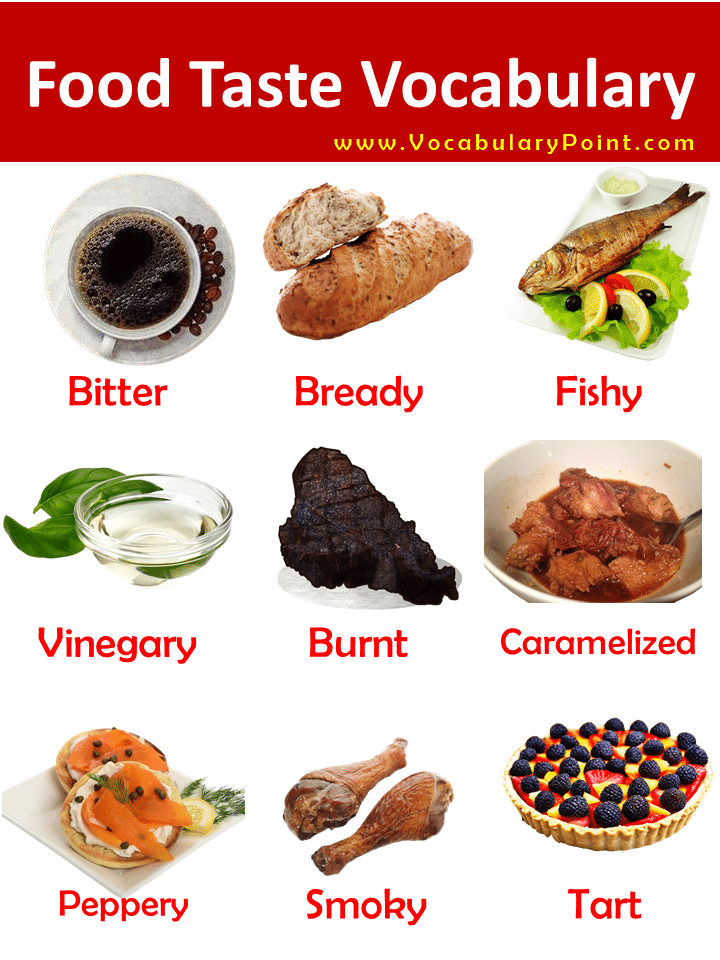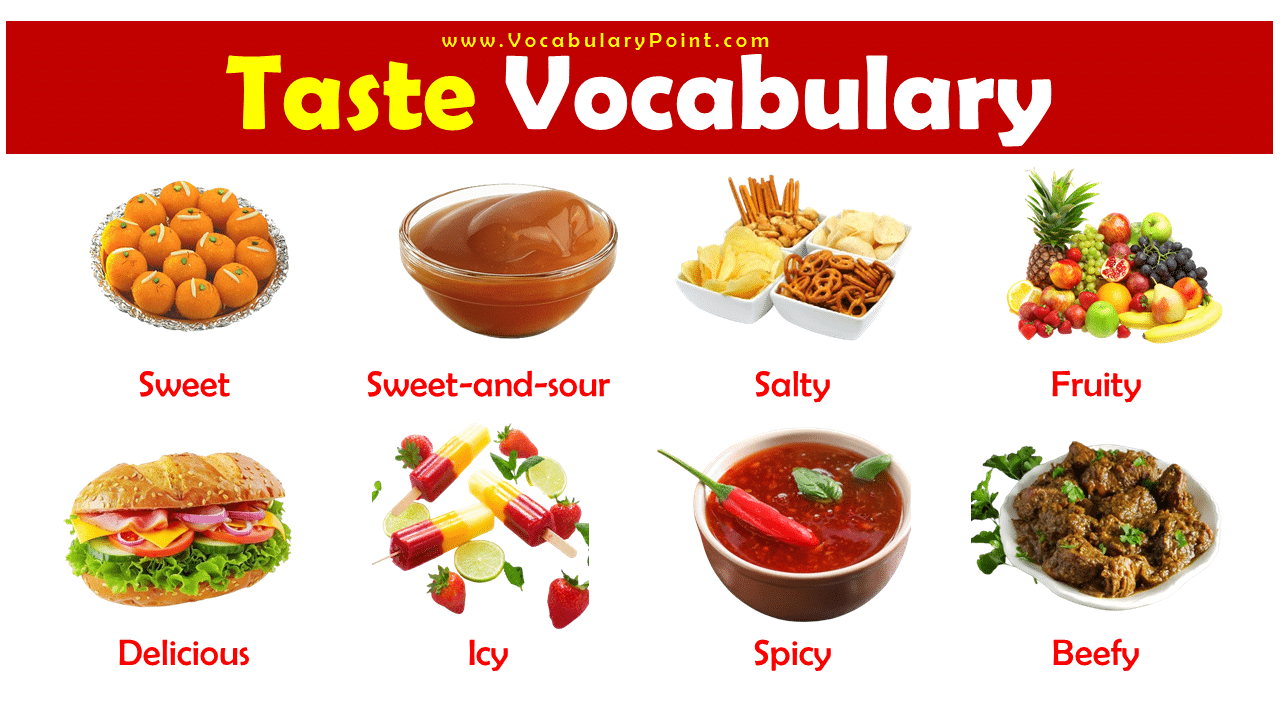Exploring taste vocabulary opens up a world of delicious flavors and helps us describe our food experiences better. This blog post introduces a variety of taste vocabulary words, perfect for English learners, kids, and students eager to expand their English skills.
We’ll learn how to express the flavors we love, the tastes that surprise us, and even the ones that might not be our favorites. By adding these words to our vocabulary, we can share our food adventures with more detail and excitement. Let’s embark on this flavorful journey together and discover the rich language of taste.
Taste Vocabulary
- Sweet
- Sour
- Salty
- Bitter
- Savory
- Umami
- Tangy
- Spicy
- Mild
- Hot
- Fiery
- Peppery
- Zesty
- Tart
- Acidic
- Rich
- Creamy
- Crisp
- Crunchy
- Soft
- Hard
- Smooth
- Velvety
- Gooey
- Chewy
- Tender
- Juicy
- Moist
- Dry
- Succulent
- Aromatic
- Fragrant
- Perfumed
- Pungent
- Stinky
- Smoky
- Earthy
- Nutty
- Buttery
- Herbal
- Floral
- Fruity
- Citrusy
- Berry-like
- Apple-like
- Tropical
- Melony
- Peachy
- Lemon-like
- Lime-like
- Orange-like
- Bready
- Yeasty
- Toasted
- Roasted
- Grilled
- Charred
- Burnt
- Caramelized
- Maple-like
- Sugary
- Honeyed
- Molasses-like
- Syrupy
- Powdered
- Granulated
- Icy
- Frozen
- Thawed
- Refreshing
- Briny
- Sea-like
- Fishy
- Gamey
- Meaty
- Beefy
- Porky
- Chicken-like
- Lamb-like
- Duck-like
- Venison-like
- Mutton-like
- Greasy
- Oily
- Fatty
- Lean
- Heavy
- Light
- Delicate
- Bold
- Subtle
- Sharp
- Mellow
- Bland
- Flavorful
- Tasty
- Delectable
- Delicious
- Exquisite
- Divine
- Heavenly
- Luscious
- Mouthwatering
- Palatable
- Satisfying
- Scrumptious
- Succulent
- Sweet-and-sour
- Umami-rich
- Vinegary
Explore More Vocabulary:
(Chocolate, Icecream, Cooking, Food & Texture)

Sweet
Tasting like sugar or honey, this flavor is often associated with desserts and fruits. It’s a basic taste sensation that is universally recognized and loved, bringing a sense of pleasure and satisfaction.
Sour
This taste is sharp, tart, and sometimes acidic, much like lemons or sour candy. It’s a lively flavor that can refresh the palate and add excitement to a dish.
Salty
Characteristic of salt, it’s one of the core basic tastes and is crucial for bringing out the flavors in food. Salty taste enhances the dining experience by highlighting other flavors present in the dish.
Bitter
A sharp, pungent taste that is often considered unpleasant when strong, but when subtle, it can add depth and complexity to food. Dark chocolate and coffee are classic examples of a desirable bitter taste.
Savory
Also known as “umami,” this taste is rich and deep, often associated with meats, cheeses, and mushrooms. It’s the meaty, broth-like flavor that makes many dishes irresistible.
Umami
A savory taste that is less well-known than the basic four, umami is a Japanese term that describes the deep earthiness found in mushrooms, ripe tomatoes, and aged cheeses.
Tangy
A taste that combines sour and a bit of sweetness, like that of yogurt or sourdough bread. It’s zesty and lively, often adding a vibrant kick to dishes.
Spicy
Not a basic taste but a sensation, spicy refers to the heat or piquancy from ingredients like chili peppers. It’s a thrilling flavor that adds excitement and intensity to food.
Mild
Gentle and not too strong in flavor or aroma, mild tastes are subtle and not overpowering, making them perfect for delicate dishes.
Hot
This refers to temperature but can also describe the sensation from spicy food. In taste vocabulary, hot often accompanies spicy dishes, enhancing the burning sensation.
Fiery
A step up from merely spicy, fiery describes an intense heat that seems to ignite the taste buds, often found in dishes with a high level of spices.
Peppery
Similar to spicy but specifically refers to the sharp, slightly hot flavor of black pepper. It’s a zingy taste that adds depth and excitement to meals.
Zesty
Refers to the refreshing and lively taste from citrus peel or fresh herbs. Zesty flavors can brighten up dishes and add a spark of freshness.
Tart
A sharp taste that’s more severe than sour, often found in certain fruits like cranberries. Tart flavors can invigorate the palate and add complexity to sweets and savories alike.
Acidic
Similar to sour but specifically refers to foods with a high acid content, like vinegar or lemon juice. Acidic tastes can cut through richness and balance flavors in a dish.
Rich
Denotes a dense, often creamy texture and deep, complex flavors. Rich tastes are satisfying and luxurious, commonly found in foods with a high fat content.
Creamy
Describes a smooth, thick texture and taste, often found in dairy products or foods that are blended to a velvety consistency. Creamy flavors are comforting and indulgent.
Crisp
Refers to a fresh, slightly firm texture and taste, often found in fresh fruits and vegetables. Crisp flavors are refreshing and invigorating.
Crunchy
A texture that’s pleasantly hard and produces a loud sound when eaten, like nuts or raw carrots. Crunchy foods add an enjoyable contrast to softer dishes.
Soft
Gentle and easy to chew or mash, soft tastes come from foods like ripe bananas or steamed vegetables. They offer a comforting and easy-to-eat experience.
Hard
Offers resistance to the bite, found in foods like raw carrots or hard candies. Hard textures can add an enjoyable challenge and variety to eating.
Smooth
Free of any lumps or bumps, smooth tastes are found in foods like custards or pureed soups. This texture is soothing and often feels luxurious.
Velvety
Similar to creamy but with a lighter, more refined texture, velvety tastes are rich yet delicate, found in fine sauces or soft cheeses.
Gooey
Sticky and thick in a way that’s pleasant and often sweet, like melted cheese or marshmallows. Gooey textures are fun and indulgent.
Chewy
Requires some effort to bite through, found in foods like tough meats or certain candies. Chewy textures can be satisfying and add a robust experience to dining.
Tender
Soft enough to cut or chew easily, often used to describe perfectly cooked meat. Tender textures are a sign of quality and care in cooking.
Juicy
Describes foods that release liquid when bitten into, like ripe fruits or succulent meats. Juicy tastes are refreshing and can enhance the flavor and enjoyment of a dish.
Moist
Slightly wet or damp, moist foods are neither too dry nor dripping with liquid. This balance is crucial for baked goods to feel fresh and satisfying.
Dry
Lacks moisture, which can be desirable in foods like crackers or undesirable in overcooked meats. Dry textures require careful balance to avoid a tough eating experience.
